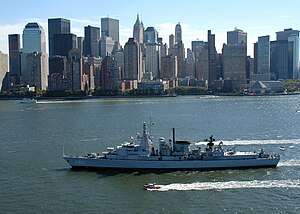Jacob van Heemskerck-class frigate

Jacob van Heemskerck in New York, 2004
|
|
| Class overview | |
|---|---|
| Name: | Jacob van Heemskerck class (L type) |
| Builders: | Royal Schelde Shipyard |
| Operators: | |
| In commission: | 1986-present day |
| Completed: | 2 |
| Active: | 2 |
| General characteristics | |
| Type: | Frigate |
| Displacement: |
|
| Length: | 130 m (426 ft 6 in) |
| Beam: | 14.5 m (47 ft 7 in) |
| Draught: | 4.4 m (14 ft 5 in) |
| Propulsion: |
|
| Speed: |
|
| Range: | 4,700 nmi (8,700 km; 5,400 mi) at 16 kn (30 km/h; 18 mph) |
| Complement: | 197 |
| Sensors and processing systems: |
|
| Armament: |
|
The Jacob van Heemskerck-class frigate was a class of frigates of the Royal Netherlands Navy. They were designed to be an air defence version of the Kortenaer class. The helicopter was replaced by a Standard medium range surface-to-air missile (SAM) system and associated radars. Two ships were built for the Royal Netherlands Navy. In 2005 they were sold to the Chilean Navy.
In the early 1970s, the Koninklijke Marine (Royal Netherlands Navy) developed what became known as the 'Standard' frigate, with anti-submarine and anti-aircraft versions using common hull designs and machinery and as far as practicable, common electronics and sensors. It was planned to order 12 anti-submarine variants (the Kortenaer class, enough to equip two task groups (each led by a Tromp-class guided missile frigate) to operate in the Atlantic, while a single anti-aircraft version would act as flagship for a third task group, consisting of the older Van Speijk-class frigates to operate in the English Channel and North Sea. In 1981, however, two Kortenaers were sold to Greece while building, and it was decided to build two anti-aircraft versions of the 'Standard' class (the 'L' class) as replacements, with the planned thirteenth 'Standard'-class frigate being abandoned.
The design's flush-decked hull, with an overall length of 130.20 metres (427.2 ft), a beam of 14.40 metres (47.2 ft) and draught of 4.23 metres (13.9 ft), is the same as used in the Kortenaers, as was the Combined gas and gas (COGAG) machinery, with two Rolls-Royce Tyne RM-1C cruise engines (3,700 kilowatts (4,900 shp)) and two Rolls-Royce Olympus TM-3 boost engines (19,200 kilowatts (25,800 shp)) drive the ship to a speed of 30 knots (35 mph; 56 km/h).
...
Wikipedia
